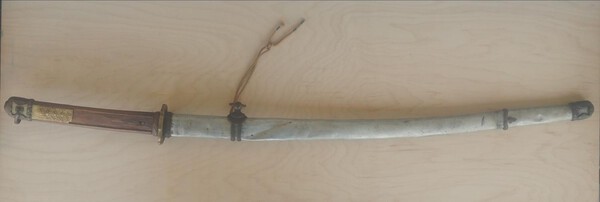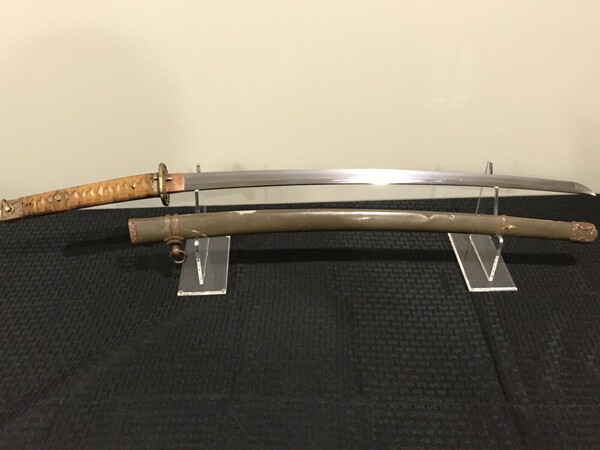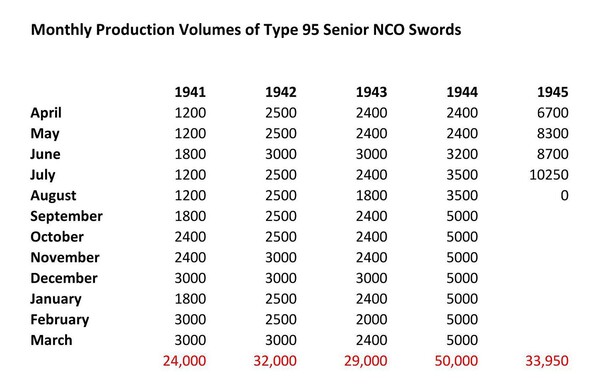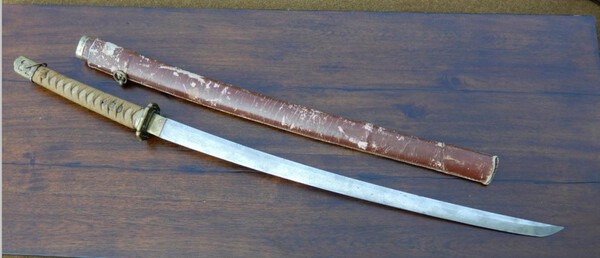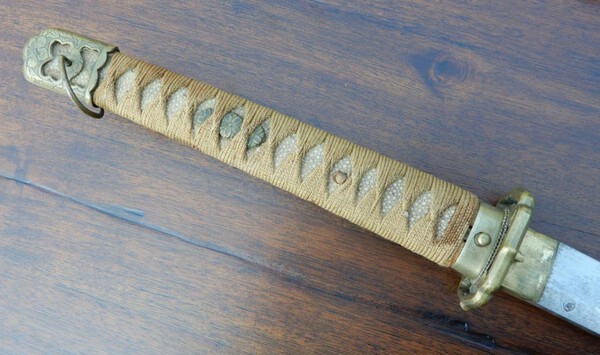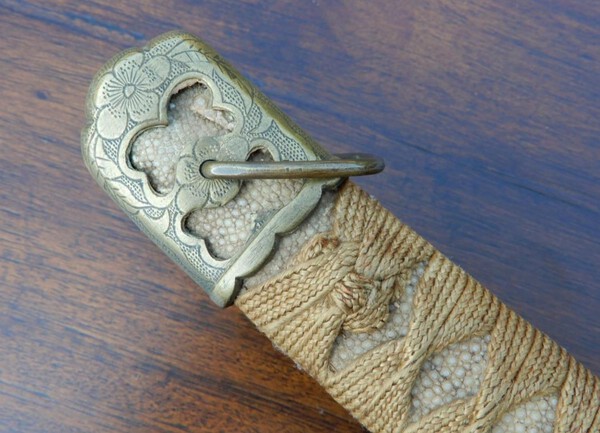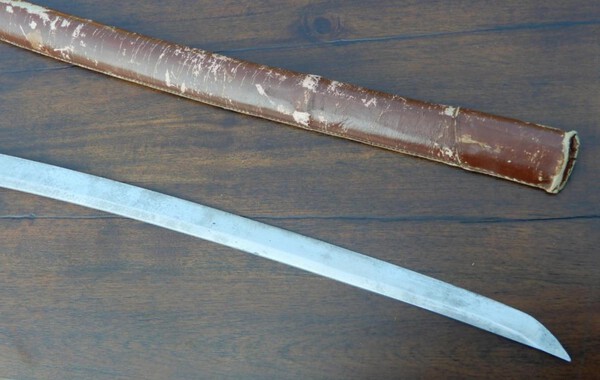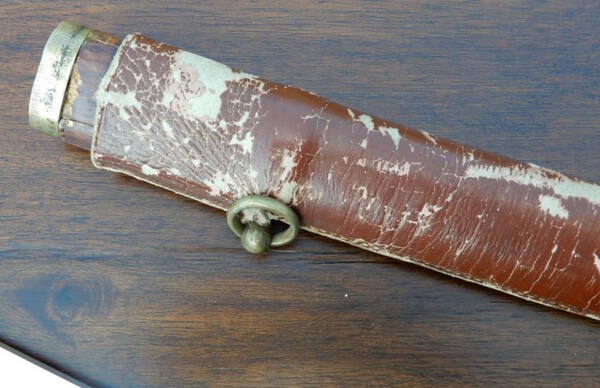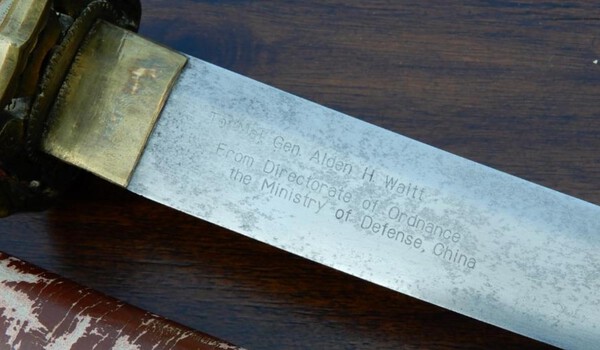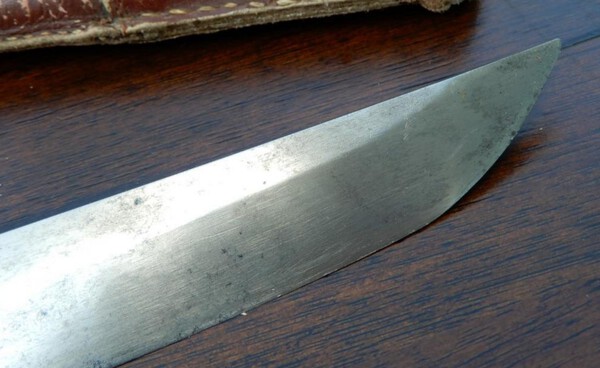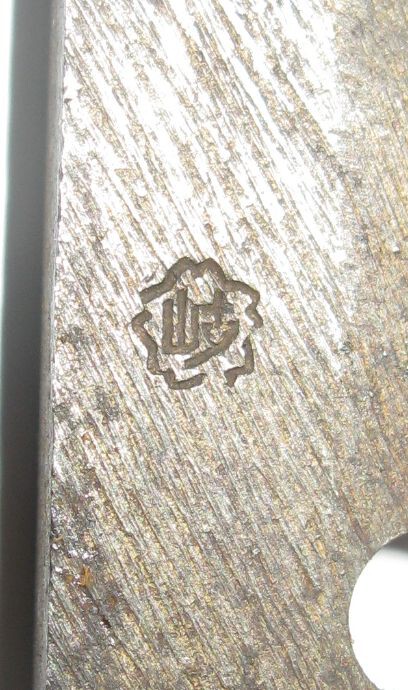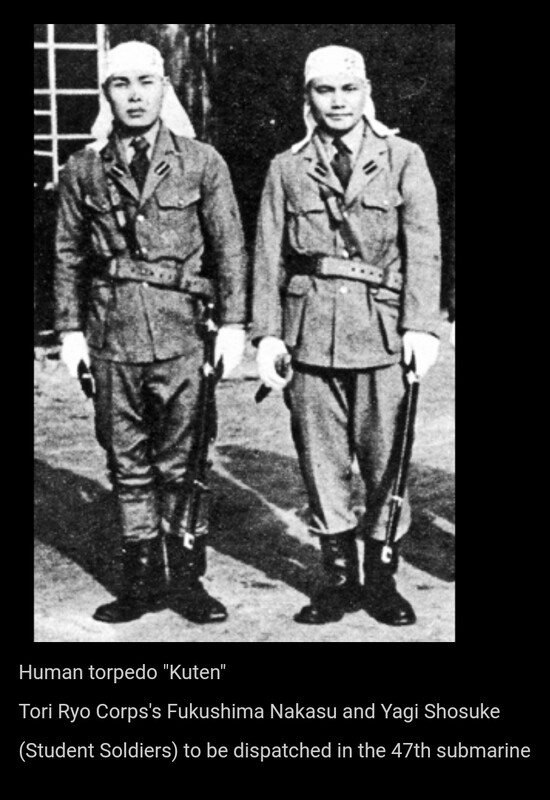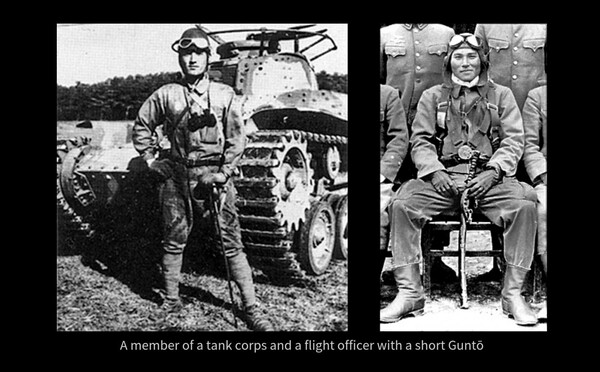-
Posts
13,000 -
Joined
-
Last visited
-
Days Won
155
Content Type
Profiles
Forums
Events
Store
Downloads
Gallery
Everything posted by Bruce Pennington
-
Another one Neil, all the paint gone, and even a bullet hole in the saya! A ‘44 blade in it. http://www.militaria.co.za/nmb/topic/29400-help-needed-identifying-gunto-sword-wwii/
-

Japanese naval dagger with mei
Bruce Pennington replied to Barry B's topic in Military Swords of Japan
That’s a beauty Barry! Have you gotten a translation yet? -

Help Needed Identifying Gunto Sword WWII
Bruce Pennington replied to Rollingthunder's topic in Military Swords of Japan
I agree Steve, good eye on that poorly struck 9! March ‘44 Mr Thunder, or may I call you Rolling?, it’s a Type 98 Japanese Officer sword (gunto). Sad shape but cool battle damage. You can read about them at this great site: http://ohmura-study.net/900.html -

A different Type 19 company grade sword
Bruce Pennington replied to PacificRim's topic in Military Swords of Japan
Alex, Nice one! I'm not sure why you call it "different". Is it the shorter, wider blade? In Dawson's book, you can see that there were multiple variations on these. In your picture with it next to the Field grade sabre, it almost appears to have a real combat blade by the curvature and shape, although, I can't see a hamon. Only way to be sure would be to remove the handle, and that is probably not easy with the 19's. Ohmura's site calls the handle material "buffalo" and the cord a Company grade that began in 1912. That's all I have, but I don't study this type. -
Thanks George! I ran the training question by Chris, and here's his reply: "Outside of the Army’s arsenals, as mentioned previously, the Army did not train smiths. The Army provided a set of specifications and the testing protocol for acceptance into the program. Applicants submitted 2 blades for testing. If the blades passed, they were contracted with and were supplied charcoal by their prefectural governor and tamahagane by the military. Their blades were to be made according to the Army’s specs, as mentioned, and inspected as I related earlier. Anyone could apply- you simply completed the application and submitted your 2 blades for testing."
-
Chris, I ran this question by Chris Bowen and got the following info. I forgot to pursue the question of exactly how the smiths were trained to meet RJT standards (or if they were simply given written specs). I'll update if I get more. From Chris: "The RJT program was more than just a set of rules and regulations specifying the parameters of construction of the sword blades- it also laid out the procedures for acceptance and participation in the program, the testing to gain acceptance, the smith’s obligations, the army’s contribution, etc. As for how it was administered, I do know that the army had both arsenal smiths and contracting smiths working all over who made blades for the program. The Tokyo Dai Ichi Rikugun Zoheisho, for example, had several smiths making blades for the program. There were similar arsenals employing RJT smiths in Kokura and Osaka. Conversely, as you theorized, correctly, there were Army admins who supervised field inspectors who made the rounds inspecting and collecting swords from smiths working at forges outside those owned and operated directly by the Army. Enomoto Sadayoshi, who was a RJT smith working in Mishima, Shizuoka, told me that during the later war years, Yoshihara Kuniie, who was both the head supervising smith at the Tokyo Arsenal, and a field inspector for the program, would come by once a month and inspect Sadayoshi’s monthly output. Those blades that met the standards were stamped with a star and bundled up and taken by Yoshihara to Tokyo. I imagine this is how things worked across the country."
-
Reading the book "A Tomb Called Iwo Jima", written from interviews with several Japanese soldiers, sailors, and airmen who were on Iwo at various stages. One of the interviewees stopped by the Minotogawa shrine on his way to shipping out, and the author noted the significance of the shrine and the adoption of the Kikusui crest by the navy: "They hefted their sea bags for the ten-minute walk to the grave of Masashige Kusunoki (1294-1336), located inside Minatogawa Jinja Shrine. They entered the main gate, and headed to the right to pay their respects at Kusunoki's grave. Kusunoki was a 14th-century samurai who gained fame for his support of the Emperor Go-Daigo during a one-sided, losing battle at Minatogawa River in 1336. This battle gave birth to his phrase, "But that I had seven lives to give to the Emperor."[18] The Japanese military used the Kusunoki family crest of a mum floating on water, called Kikusui, as a symbol of devotion and self-sacrifice. The Navy adopted Minatogawa Jinja as their patron shrine."
-

Japanese naval dagger with mei
Bruce Pennington replied to Barry B's topic in Military Swords of Japan
Barry, Hopefully, some of the guys who really collect dirks will chime in, but it is my impression that none of the dirk makers made what I call "real" blades, they all made the "machine made" blade with artificial hamon. When you see one with a signed, real blade, it was a privately owned tanto that was refitted for the war in dirk fittings. I suppose a guy might have gone out and commissioned a custom made tanto in naval dirk fittings, too, but that would be evident if the blade date could be determined. Obviously, a nakago with much age would fit into the refitted scenario. -
-

Attention Mantetsu Owners: A Survey
Bruce Pennington replied to Bruce Pennington's topic in Military Swords of Japan
That's definitely a possiblity that had not occured to me! Tokyo would be the place where the majority of the outfitters were found, as well as the natural location for distribution to Officer Clubs and sellers. -

Attention Mantetsu Owners: A Survey
Bruce Pennington replied to Bruce Pennington's topic in Military Swords of Japan
Great John, didn't have that one! It's a "Nan" stamped, non-Koa, with "W", my second '44 marked so. These muddy my theory that Mukden made these Nan-stamped blades because I'm fairly certain the W inspector mark originates at the Tokyo Arsenal. I suppose one idea is that the Tokyo Arsenal had an inspector working the Mukden arsenal, or Mukden inspectors used the W on authority of Tokyo? I wish I knew more about how that process worked. -

The Mysterious "w" Stamp!
Bruce Pennington replied to Bruce Pennington's topic in Military Swords of Japan
I have found that to be true on many of these, including the Mantetsu. Another mystery! Off hand, I can't think of any other inspector stamps that are marked twice on the side of a nakago. I've seen Na and Seki stamps on the face and mune, but not on the same side of the face, twice. Hmmmm... -
Matt, As far as I know, they were always short of the needed gunto. Good article on this here: http://www.warrelics.eu/forum/Japanese-militaria/family-short-blades-gunto-688110/ I had always assumed the same thing as you, that our bombing and war materiel shortages had decreased production by the latter years, but this chart on NCO type 95 production seems to say quite the oposite. I don't know about officer gunto production though.
-

To restore or not to restore?
Bruce Pennington replied to IJASWORDS's topic in Military Swords of Japan
My feelings exactly! I have had a couple of NCO 95's, though, with terrible Bubba paint jobs that I stripped the post-war paint off. I got lucky on 1 which still had its original paint. The other had been completely stripped to the metal, though, and I was left with a Type 95 with no paint at all. So I repainted. It looks too new, and the tsuka too shiny; but it's better than either the Bubba paint (which was all gold, even the blade!), or bare metal. I wouldn't do it with an officer saya, or any gunto with original paint. -
Posting, to preserve the pics when the sale site no longer carries them. He states that he won't remove the tsuka in the description. The sale also includes a book written by the general on gas warfare.
-

To restore or not to restore?
Bruce Pennington replied to IJASWORDS's topic in Military Swords of Japan
I would restore if I could get the seppa right. And I’d rather buy a rewrapped gunto, if professionally done. Gunto were repaired and rewrapped during the war, just as an old blade wore many fittings in its life. As long as the parts are WWII, and full disclosure is made, I’d rather buy something that looks nice than something that looks like junk. But that’s me. I have several spare seppa if you decide to refit. I can send pictures of them if interested. -
Sorry for the constant updates, but I've re-arranged the doc a bit to make it flow in a more logical order. Also realized I had no actual pics of basic stamps like Sho, Seki, Gifu, Star; now added.
-

Looking for a Good, Clear Showa Stamp
Bruce Pennington replied to Bruce Pennington's topic in Military Swords of Japan
NIce, thanks Brian - updated. -

Looking for a Good, Clear Showa Stamp
Bruce Pennington replied to Bruce Pennington's topic in Military Swords of Japan
Thanks Ronnie! I've added it to the doc. Now that we're rolling - the PERFECT Gifu anyone? I have this one, but it's missing the bottom right leg of the crossed swords. (the one on Ohmura's site is missing the same leg, too) -
Thanks Trystan. It is good to know the actual names.
-
Nice find, Neil! I know I'm one of the worst when it comes to speculating on the unknown, and the "aircrew/tanker" gunto is one of the best examples of why we should avoid doing it. Book writers and website hosts (Ohmura) helped create this myth. They are just waki's fitted for WWII. Matt's video is a good example - guys just bought what they wanted, or brought what they had from home. Although, Ohmura admits that crews didn't always pick waki: "However, crews did not necessarily choose a short Guntō. A large majority of crews were doing the carrying of the Johsun-Guntō so that it might understand also with the upper photograph." His site has pics of submariners and aircrew carrying full sized gunto, though he does have a picture of a tanker & and aircrew with shorties. Another term we used, and I've used it often, that I wonder about is the "combat saya", the leather-covered wood saya. Is that really a term from WWII Japanese? Ohmura calls them "formal" and "informal" saya, but I doubt that was truly their style names to the soldiers carrying them, as many, if not most, of the "formal" saya we see today were collected on the battle field.
-

Looking for a Good, Clear Showa Stamp
Bruce Pennington replied to Bruce Pennington's topic in Military Swords of Japan
Now to find that PERFECT seki stamp .... -

Looking for a Good, Clear Showa Stamp
Bruce Pennington replied to Bruce Pennington's topic in Military Swords of Japan
Glad you mentioned it Ed, I wouldn't have thought of it on this one! So noted, and anotated! Thanks again. -

Looking for a Good, Clear Showa Stamp
Bruce Pennington replied to Bruce Pennington's topic in Military Swords of Japan
Thanks JP, that's going in the doc! -

Looking for a Good, Clear Showa Stamp
Bruce Pennington replied to Bruce Pennington's topic in Military Swords of Japan
Thanks Ed, nice one!


